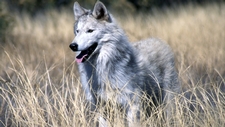Predator and Prey
Readiness

TEKS Objective
The student is expected to describe how the flow of energy derived from the Sun, used by producers to create their own food, is transferred through a food chain and food web to consumers and decomposers.
Essential Understanding
The student knows that there are relationships, systems, and cycles within environments.
Science Background
Predator-Prey Relationship: Texas Parks & Wildlife (website) - Informative article that describes the roles of predators and prey in an environment. It emphasizes that there is no such thing as a “good” or “bad” animal. Rather, organisms simply prey on others to survive, and in fact, even predators can become prey.
Predator-Prey Relationship
Texas Parks & Wildlife, www.tpwd.state.tx.us
Food Chains and Cycles: BBC Bitesize (website) - Food chains illustrate the feeding relationships among living things. Learn more about the transfer of energy through food chains as you navigate this website.
Signature Lesson
Predator/Prey: Edwards YMCA Camp (website) - Animals battle for survival every day, seeking food for themselves while avoiding being eaten by other members of their food webs. This lesson helps students to understand the transfer of energy through food webs, the relationships among producers, consumers and decomposers, population dynamics, and adaptations that enable predators and prey to survive.
- Supporting Lessons
- Extensions
- Assessment Ideas
- Literature Connections
- Related
TEKS - Additional Resources
Supporting Lessons
Predator-Prey Interactions: University of Georgia (website) - Students investigate and describe predator-prey interactions using a variety of small vertebrate predators. The activity recommends and is designed around Daphnia and fish that must be ordered form a science supply company. Instead, we recommend adjusting the activity to use crickets and anoles, which are more readily available. If you do substitute organisms, be sure to make the necessary changes on the student data sheets. (All necessary lesson plan information, student pages, etc. are available for download via the red links at the bottom of the page.)
Predator-Prey Interactions
University of Georgia, www.uga.edu
Elaboration Lessons and Extensions
Be A Predator for a Day Game: University of Georgia (website) - In this game, students assume the roles of different predators (king snake, bobcat, alligator, etc.) and must locate the appropriate “prey” items in the classroom. (Templates are provided.) This activity leads naturally to discussion of concepts related to energy transfer within a food chain, adaptation and food quality.
Be A Predator for a Day Game
University of Georgia, srel.uga.edu
Assessment Ideas
Have students answer the following questions (answers in parentheses).
- How do both predators and prey benefit from their relationship? (Predators obtain food from their prey. Surviving prey sometimes benefit because predators maintain populations of prey animals at levels that can be supported by the environment.)
- What might happen if all the prey of a certain predator were destroyed? (The predators would either have to find a new food source or they would die, too.)
- What might happen if all predators of a particular organism were killed off? (Initially, the prey would multiply. However, as the population expanded, the prey eventually would exhaust available sources of food and shelter. The ecosystem would be unable to support the larger population, so some of the the prey individuals would begin to die, or they would evolve to exploit new resources in the same location or a different one).
- Review the concept of a food web with students. Ask, “What would happen if a predator fed on only one kind of prey?” (Predator population numbers would closely follow prey population levels).
Literature Connections
Predators and Prey. Chinery, Michael (ISBN-13: 978-0778702276)
Who Eats What: Food Chains and Webs. Lauber, Patricia (ISBN-13: 978-0064451307)
The World of Food Chains with Max Axiom, Super Scientist. O’Donnell, Liam (ISBN-13: 978-0736868396)
Food Webs: Interconnecting Food Chains. Gray, Susan (ISBN-13: 978-0756532611)
Pass the Energy, Please! Shaw Mckinney, Barbara (ISBN-13: 978-1584690016)
Additional Resources
Keep Texas Wild: Texas Parks & Wildlife (website) - Challenge students to “invent” an animal or to research selected Texas predators and their prey from articles provided on this site. This activity is related to a “TWP” magazine issue this no longer is available; however, it can be conducted as a stand-alone lesson using the free, downloadable kids’ pages and wildlife fact sheets available on the site.
Keep Texas Wild
Texas Parks & Wildlife, www.tpwd.state.tx.us
Chain Reaction: EcoKids (website) - Have students work through this animated game to learn the basics about producers and consumers in two different food chains.
Chain Reaction
EcoKids, www.ecokids.ca
Owl Pellets: Council for Environmental Education (PDF) - Use owl pellets (must be ordered from a scientific supply company) to teach students about predators, prey and food chains. Includes necessary student sheets.
Owl Pellets
Council for Environmental Education, Project Wild, www.projectwild.org
TEKS Navigation
Grade 5
User Information
Not Registered Yet?
Sign Up Today!
Need Assistance?
If you need help or have a question please use the links below to help resolve your problem.

Comments